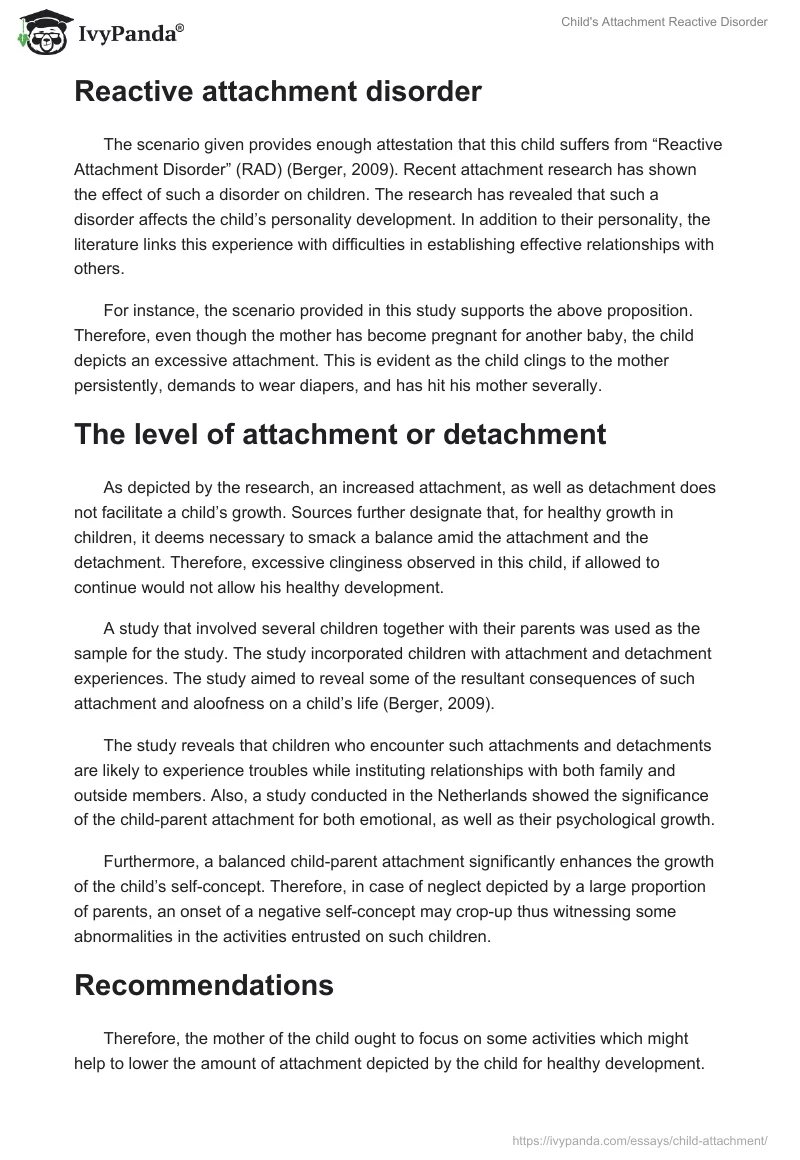Introduction
Psychologists define the term attachment as a situation whereby an individual feels emotionally attached to another individual. The attachment is common among children who are below five years of age. Several reasons are responsible for the attachment.
Psychologists have revealed that caregivers who devote a lot of time to their children help to instill an aspect of security for them. Thus, children who feel threatened usually seek a haven from their caregivers (Berger, 2009). The context provided is an appropriate example of showing how children are attached to their parents.
Although the mother of this child has become pregnant, the two-year-old son keeps disturbing her. The child demands to put on diapers despite his growth in age. Therefore, it is crucial to know the provisions of the attachment research on how the mother should respond to the child’s behavior.
The process of child rebirth
Sources have exposed some of the difficulties that parents of children with the attachment disorder encounter. This is because they have a responsibility of bestowing their children’s love and trust thus experiencing normal life. Literature has illustrated the complexity linked with the child’s healing process (Bradley, 2007).
Although the process is time intensive, parents ought to devote themselves to enhancing their children’s wellness. Numerous psychologists have argued that the sole way to regenerate a child’s attachment would be through rebirth. They further clarify what the rebirth procedure entails.
They describe rebirth as a process that bestows the love and care that such parents once showed to their children after birth. Therefore, for success in achieving the parent’s intentions, sources show the importance of both parents working unanimously (Schaffer, 2003).
Reactive attachment disorder
The scenario given provides enough attestation that this child suffers from “Reactive Attachment Disorder” (RAD) (Berger, 2009). Recent attachment research has shown the effect of such a disorder on children. The research has revealed that such a disorder affects the child’s personality development. In addition to their personality, the literature links this experience with difficulties in establishing effective relationships with others.
For instance, the scenario provided in this study supports the above proposition. Therefore, even though the mother has become pregnant for another baby, the child depicts an excessive attachment. This is evident as the child clings to the mother persistently, demands to wear diapers, and has hit his mother severally.
The level of attachment or detachment
As depicted by the research, an increased attachment, as well as detachment does not facilitate a child’s growth. Sources further designate that, for healthy growth in children, it deems necessary to smack a balance amid the attachment and the detachment. Therefore, excessive clinginess observed in this child, if allowed to continue would not allow his healthy development.
A study that involved several children together with their parents was used as the sample for the study. The study incorporated children with attachment and detachment experiences. The study aimed to reveal some of the resultant consequences of such attachment and aloofness on a child’s life (Berger, 2009).
The study reveals that children who encounter such attachments and detachments are likely to experience troubles while instituting relationships with both family and outside members. Also, a study conducted in the Netherlands showed the significance of the child-parent attachment for both emotional, as well as their psychological growth.
Furthermore, a balanced child-parent attachment significantly enhances the growth of the child’s self-concept. Therefore, in case of neglect depicted by a large proportion of parents, an onset of a negative self-concept may crop-up thus witnessing some abnormalities in the activities entrusted on such children.
Recommendations
Therefore, the mother of the child ought to focus on some activities which might help to lower the amount of attachment depicted by the child for healthy development. Psychologists have specified the significance of putting limits to the level of attachment with their children (Bradley, 2007).
Such boundaries are essential as they support the child while developing significant virtues in life. Thus, for the healthy development of the child, it would be necessary for the mother to limit her child’s freedom a little. Since children are the victims of the attachment disorder, the mother will have to undergo some counseling to cope with the child’s behavior easier (Schaffer, 2003).
Therefore, it will be significant to let her understand the advantages of putting some boundaries on the child’s attachment level. In addition to the limits, it would be necessary to enlighten her on the significance of involving both parents in the child’s healing process.
Conclusion
Therefore, the above paper touches on some of the propositions of the attachment research in resolving issues of the child’s reactive disorder. The research has stressed the significance of striking a balance between the degree of attachment and detachment between parents and their children.
As it is evident from the scenario provided, it would be necessary for the mother letting the child understand that some behaviors are unacceptable. It would also be necessary to involve all parents in the practice of raising the child.
References
Berger, K. (2009). The developing person: through childhood and adolescence. New York, NY: Worth Publishers.
Bradley, S. (2007). Enhancing early attachments: theory, research, intervention, and policy. J Can Acad Child Adolesc Psychiatry, 6(1), 33–36.
Schaffer, R. (2003). Introducing child psychology. Malden, MA: Wiley-Blackwell.


